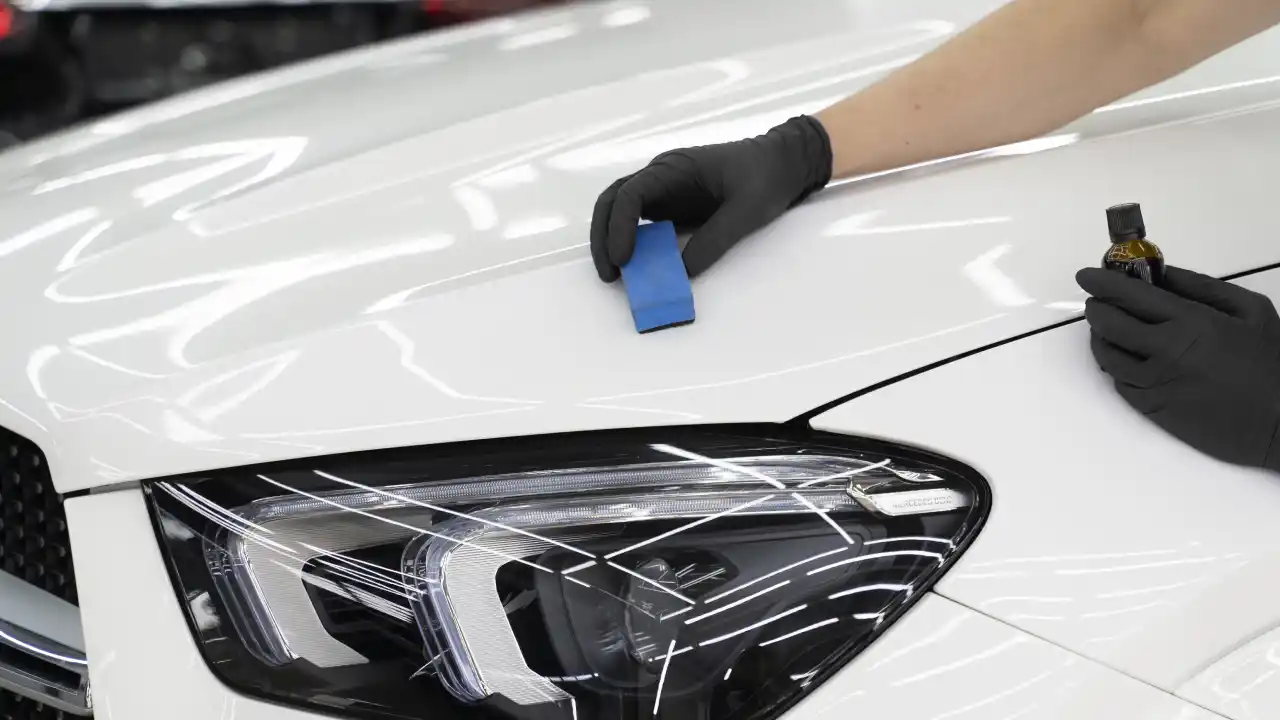Checking Out the Scientific Research Behind Ceramic Coating and Its Influence On Auto Detailing
The application of ceramic finish in auto describing stands for a substantial innovation in auto treatment, rooted in its innovative chemical homes, mainly silica dioxide and titanium dioxide. As we check out the ins and outs of the application procedure and the long-lasting ramifications for car maintenance, it comes to be clear that the selection of ceramic coating can basically modify one's strategy to automobile care.
What Is Ceramic Layer?
Ceramic coating is a contemporary remedy that has obtained appeal in the auto outlining market for its capability to provide lasting security for vehicle surface areas. This innovative protective layer is commonly made up of silica dioxide (SiO2), which creates a strong bond with the vehicle's paint, developing a resilient guard versus environmental impurities. Unlike traditional wax or sealants, ceramic layers provide premium resistance to UV rays, chemical stains, and physical abrasions.
The application of ceramic finishing entails a meticulous process, where the lorry's surface is extensively cleaned and decontaminated prior to the layer is applied (Ceramic Coating). Once treated, the layer boosts the vehicle's gloss, depth, and clearness, giving a showroom-quality coating that lasts for years. One of the essential benefits of ceramic layer is its hydrophobic homes, which drive away water and dust, making upkeep easier and reducing the frequency of washes
The Chemistry of Ceramic Finishing
A basic facet of ceramic layer hinges on its chemical make-up, primarily characterized by the presence of silica dioxide (SiO2) This compound is integral to the formation of a durable, protective layer that bonds chemically to the vehicle's surface area. When used, the SiO2 particles undertake a procedure known as polymerization, wherein they create a network of interconnected frameworks. This causes a robust, hydrophobic surface that wards off water and pollutants.
In enhancement to SiO2, several ceramic finishes integrate titanium dioxide (TiO2) and other ingredients to improve their performance features. TiO2, as an example, adds to increased solidity and chemical resistance. The interaction in between these substances creates an unique molecular framework that uses a high level of defense against ecological aspects such as UV rays, acid rain, and oxidation.
In addition, the application process often entails a precise prep work of the surface to ensure ideal adhesion of the finish. This chemistry not only makes certain a resilient finish however also improves the visual charm of the vehicle. Comprehending the intricate chemistry behind ceramic finishes is important for describing professionals that intend to supply superior security and long life for their clients' lorries.
Benefits of Ceramic Finish
While outlining experts commonly highlight the benefits of ceramic layers, their advantages expand much past aesthetics. Ceramic coverings create a hydrophobic surface that wards off water, dirt, and gunk, significantly reducing the frequency of cleans and the initiative needed to preserve an automobile's appearance.
Furthermore, ceramic finishes improve the durability of the car's finish. Unlike traditional waxes or sealers, which might last a few months, ceramic coverings can endure for years, giving a lasting option for cars and truck treatment. This longevity equates to cost savings, as proprietors are less likely to require regular reapplication.
Additionally, ceramic layers are immune to chemical stains and etching, which can take place from acidic compounds like bird droppings or tree sap. This resistance not only maintains the car's visual appeals yet additionally decreases prospective damage - Ceramic Coating. On the whole, the investment in ceramic coating uses automobile owners a considerable return in terms of security, ease of upkeep, and long-lasting aesthetic allure, making it a progressively preferred option in the world of automobile describing
Application Process Described

When the surface is appropriately prepared, the ceramic finish can be applied. Using an applicator pad, the technician uses the coating in tiny areas, working in a crosshatch pattern to ensure also coverage.
When healed, the ceramic covering develops a solid bond with the paint, providing improved security and a shiny finish. Appropriate application is crucial to make the most of the durability and performance of the ceramic covering.

Long-lasting Effect On Vehicle Care
The lasting influence of ceramic layer on lorry care is significant, as it basically changes how proprietors preserve their cars. By creating a sturdy, hydrophobic layer on the car's surface, ceramic layers lessen the adherence of dirt, crud, and pollutants. This home reduces the regularity of washing called for, ultimately preserving water and cleaning items.
Furthermore, the UV defense provided by ceramic coatings assists to prevent oxidation and fading of the automobile's paint, i loved this preserving its aesthetic allure and resale value with time - Ceramic Coating. This protective barrier additionally minimizes the likelihood of scrapes and swirl marks, which prevail problems in traditional paint surfaces
In addition, ceramic coverings promote simpler upkeep, permitting owners to cleanse their vehicles with very little initiative. The smooth surface area makes it challenging for pollutants to bond, making it possible for Continue simpler removal throughout regular cleansing.
Over time, the financial investment in ceramic coating may result in cost savings in automobile treatment services and products. Overall, the withstanding benefits of ceramic layers not only enhance the appearance of cars however additionally add to an extra sustainable and effective technique to automobile upkeep.
Verdict
To conclude, the application of ceramic covering represents a considerable improvement in auto detailing, driven by its distinct chemical structure of silica dioxide and titanium dioxide. This innovation not just improves the visual charm of automobiles yet also provides durable protection versus ecological hazards and wear. The lasting advantages, consisting of minimized upkeep regularity and improved sturdiness, highlight the value of ceramic coatings as a necessary investment for preserving car appearance and honesty with time.
